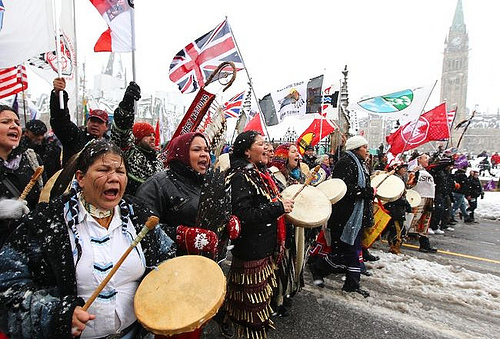
Canada’s Globe and Mail asks, “What’s behind the explosion of native activism?” Their answer? “Young people.” As usual, the answer hides as much as it reveals.
The explosion of Native activism, organizing, and sheer presence across Canada, has been ignited and inspired by Chief Theresa Spence and by the four women founders of Idle No More — Jessica Gordon, Nina Wilson, Sylvia McAdam, Sheelah McLean. These five women are not behind the explosion. They are the explosion.
At the same time, the fire that continues is indeed made up of young Native people, specifically, young Native women. The Globe and Mail focus on Erica Lee, a former student of Sheelah McLean, and Tala Tootoosis, a Facebook friend of Nina Wilson’s, suggests as much.
Young Native women have always been organizing. One example would be Jessica Yee Danforth, who describes herself as a “multiracial Indigenous hip-hop feminist reproductive justice freedom fighter!” Founder and Executive Director of the Native Youth Sexual Health Network, Yee Danforth is also the editor of Feminism for Real: Deconstructing the academic industrial complex of feminism, and a maker, shaker, and movement builder.
In 2011, on her way to the UN Climate Change Conference COP 17, Yee commented, “Climate change, for us, is a central issue because it has to do with what’s going on in our lands and our territories. And the way that we think about climate change is very broad. …When things impact our land and our air, they simultaneously impact our people and what’s going on in our communities. And for us, we understand that if we’re going to be talking about environmental issues of any sort, that woman in fact is the first environment. …What climate change is doing is not allowing our women to have healthy pregnancies. It is creating situations where there’s more violence in our communities, because of industry, for example. …We’re talking about issues of genocide. We’re talking about issues of survival of our peoples. And I know that we’re going to have some uncomfortable conversations even with organizers in our own communities this week, who just want to see this as a land-only issue or as an air-only issue and not understand that women being the first environment or the simultaneous, intersecting effects are really critical.”
What does this have to do with the current explosion of `raw energy’? Everything. Women are the first environment. Native women, young Native women and Native women elders, have always known this. When Jess Housty, a young Heiltsuk woman Idle No More organizer, explains, “I believe it’s in the best interests of people who care about the environment to support this,” she is invoking woman as the first environment. When Innu elder Marie Louise Andre Mackenzie explains, “I will always protect my land and my language,” she too understands, and teaches, women as the first environment. The Native women who researched and gathered stories of the hundreds upon hundreds of Aboriginal women and girls “missing” across Canada, and buried and lost in Canadian national policy. When those Native women refused to let their sisters go, refused to treat them as less than nothing, they understood, and insisted, that woman is the first environment.
These Native feminisms and feminists continually engaged and continually write deeper maps as they deepen and broaden the world. Behind the explosion of Native activism lies centuries of Native women’s resistance and emancipatory organizing and mobilizing. Right now, daily, across Canada and beyond, Native women, and in particular young Native women, are lighting the flame and taking it forward. Woman is the first environment. Remember that.
(Photo Credit: Rabble)